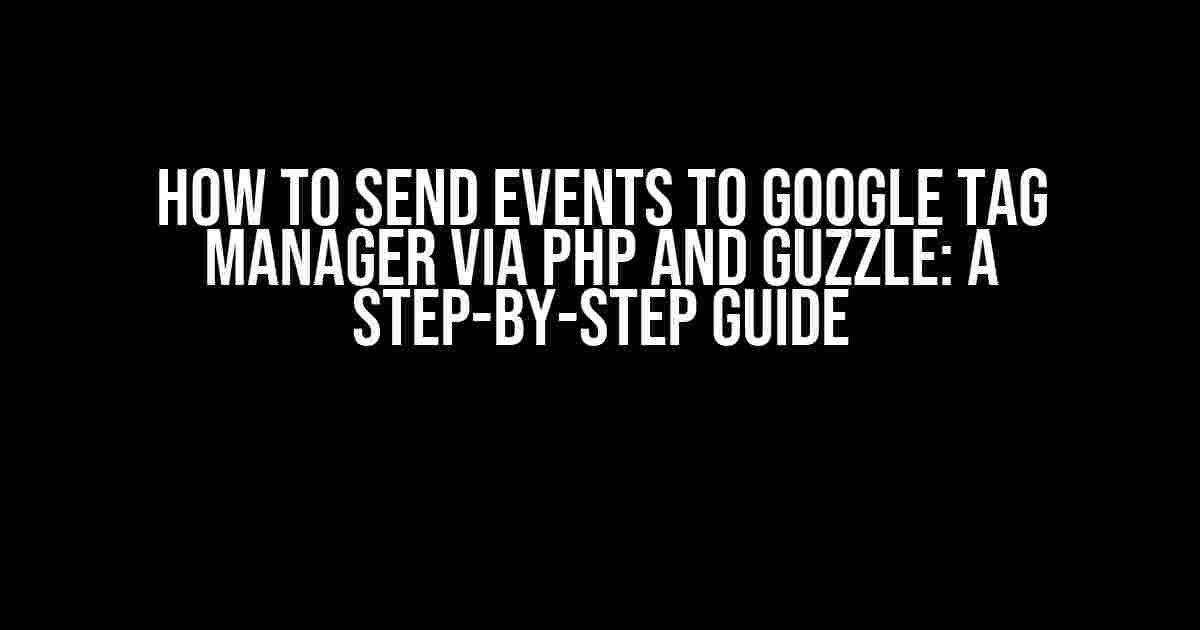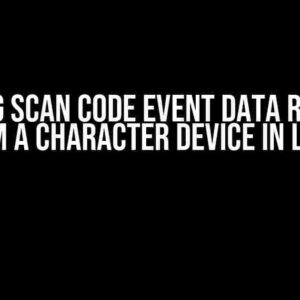Are you tired of manually tracking user interactions on your website? Do you want to unlock the power of Google Tag Manager (GTM) to supercharge your analytics and marketing efforts? Look no further! In this comprehensive guide, we’ll show you how to send events to Google Tag Manager via PHP and Guzzle, step by step.
What is Google Tag Manager?
Before we dive into the nitty-gritty, let’s quickly cover what Google Tag Manager is. GTM is a free tag management system that allows you to manage and deploy marketing and analytics tags on your website without requiring IT support. With GTM, you can easily track user interactions, such as clicks, form submissions, and scroll depth, and use this data to inform your marketing strategy.
What is Guzzle?
Guzzle is a popular PHP HTTP client that makes it easy to send HTTP requests to APIs. In our case, we’ll use Guzzle to send events to Google Tag Manager’s API.
Setting Up Google Tag Manager
Before we can send events to GTM, we need to set it up on our website. Here are the steps:
- Create a Google Tag Manager account and create a new container.
- Install the GTM container snippet on your website. This code should be placed in the
section of your HTML. - Create a new tag in GTM. For this example, we’ll create a “Track Event” tag.
- Set up the trigger for the tag. In this case, we’ll use a “Custom Event” trigger.
- Save the tag and publish the container.
Setting Up Guzzle in PHP
Now that we have GTM set up, let’s install Guzzle in our PHP project using Composer.
composer require guzzlehttp/guzzle
Once installed, we can create a new instance of the Guzzle client:
$client = new \GuzzleHttp\Client();
Sending Events to Google Tag Manager via Guzzle
Now that we have Guzzle set up, we can send events to GTM using the following code:
use GuzzleHttp\Client;
$client = new Client();
$data = [
'v' => '1',
'tid' => 'UA-XXXXX-X', // Your GTM container ID
'cid' => '123456789.123456789', // Anonymous client ID
't' => 'event',
'ec' => 'Category', // Event category
'ea' => 'Action', // Event action
'el' => 'Label', // Event label
'ev' => 'Value' // Event value
];
$response = $client->post('https://www.google-analytics.com/collect', ['json' => $data]);
if ($response->getStatusCode() === 200) {
echo 'Event sent successfully!';
} else {
echo 'Error sending event: ' . $response->getReasonPhrase();
}
In this example, we’re sending an event to GTM with the following parameters:
v: The protocol version (in this case, version 1)tid: Your GTM container IDcid: An anonymous client ID (you can generate this using a library like ramsey/uuid)t: The hit type (in this case, an event)ec: The event categoryea: The event actionel: The event labelev: The event value (optional)
Handling Errors and Debugging
When sending events to GTM, it’s essential to handle errors and debugging properly. Here are some tips:
- Use try-catch blocks to catch any exceptions thrown by Guzzle.
- Log errors and responses using a logging library like Monolog.
- Use the
curlcommand-line tool to test your API requests and debug any issues. - Check the GTM debug console to ensure your events are being tracked correctly.
Real-World Examples and Use Cases
Now that we’ve covered the basics, let’s explore some real-world examples and use cases for sending events to GTM via PHP and Guzzle:
| Use Case | Description |
|---|---|
| Tracking form submissions | Send an event to GTM when a user submits a form, and include form data as event parameters. |
| Tracking scroll depth | Send an event to GTM when a user scrolls to a certain depth on a page, and include scroll position as an event parameter. |
| Tracking file downloads | Send an event to GTM when a user downloads a file, and include file name and type as event parameters. |
| Tracking video interactions | Send an event to GTM when a user interacts with a video, such as playing, pausing, or seeking. |
These are just a few examples of the many use cases for sending events to GTM via PHP and Guzzle. By following this guide, you’ll be well on your way to unlocking the power of GTM and taking your analytics and marketing efforts to the next level.
Conclusion
In this comprehensive guide, we’ve covered the steps to send events to Google Tag Manager via PHP and Guzzle. By using Guzzle to send HTTP requests to the GTM API, you can track user interactions and unlock valuable insights into your website’s usage. Remember to handle errors and debugging properly, and explore the many use cases for sending events to GTM. Happy tracking!
Have any questions or need further assistance? Feel free to ask in the comments below.
Frequently Asked Question
Get ready to turbocharge your Google Tag Manager with PHP and Guzzle! Here are the answers to the most frequently asked questions about sending events to Google Tag Manager via PHP and Guzzle.
What is the basic prerequisite to send events to Google Tag Manager via PHP and Guzzle?
To send events to Google Tag Manager via PHP and Guzzle, you need to have a basic understanding of PHP, Guzzle (a PHP HTTP client), and the Google Tag Manager API. You’ll also need to set up a Google Tag Manager account and create a container to store your tags.
How do I install Guzzle to use with PHP?
You can install Guzzle using Composer, a popular PHP dependency manager. Simply run the command `composer require guzzlehttp/guzzle` in your terminal to install Guzzle.
What is the format of the data sent to Google Tag Manager via PHP and Guzzle?
The data sent to Google Tag Manager via PHP and Guzzle should be in JSON format. You’ll need to create a JSON object with the required parameters, such as `v` (protocol version), `tid` (tracking ID), `cid` (client ID), and `t` (event type).
Can I send custom events to Google Tag Manager via PHP and Guzzle?
Yes, you can send custom events to Google Tag Manager via PHP and Guzzle. You can create a custom event by specifying the `t` parameter as `event` and providing additional parameters, such as `ec` (event category), `ea` (event action), and `el` (event label).
How do I handle errors when sending events to Google Tag Manager via PHP and Guzzle?
You can handle errors by using try-catch blocks in your PHP code. Guzzle also provides error handling mechanisms, such as the `GuzzleHttp\Exception\RequestException` class, which can help you catch and handle errors when sending events to Google Tag Manager.
I hope you found these answers helpful!


